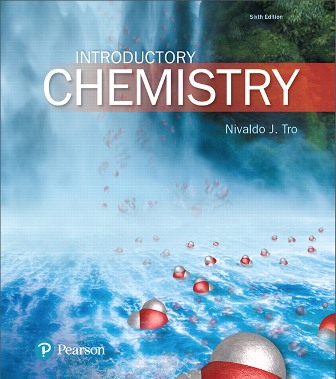Description
Solution Manual for Introductory Chemistry, 6th Edition, Nivaldo J. Tro, ISBN-10: 0134302389, ISBN-13: 9780134302386, ISBN-10: 013429081X, ISBN-13: 9780134290812
Table of Contents
1 The Chemical World
1.1 Sand and Water
1.2 Chemicals Compose Ordinary Things
1.3 The Scientific Method: How Chemists Think
1.4 Analyzing and Interpreting Data
1.5 A Beginning Chemist: How to Succeed
2 Measurement and Problem Solving
2.1 The Metric Mix-up: A $125 Million Unit Error
2.2 Scientific Notation: Writing Large and Small Numbers
2.3 Significant Figures: Writing Numbers to Reflect Precision
2.4 Significant Figures in Calculations
2.5 The Basic Units of Measurement
2.6 Problem Solving and Unit Conversion
2.7 Solving Multistep Unit Conversion Problems
2.8 Unit Conversion in Both the Numerator and Denominator
2.9 Units Raised to a Power
2.10 Density
2.11 Numerical Problem-Solving Strategies and the Solution Map
3 Matter and Energy
3.1 In Your Room
3.2 What Is Matter?
3.3 Classifying Matter According to Its State: Solid, Liquid, and Gas
3.4 Classifying Matter According to Its Composition: Elements, Compounds, and Mixtures
3.5 Differences in Matter: Physical and Chemical Properties
3.6 Changes in Matter: Physical and Chemical Changes
3.7 Conservation of Mass: There Is No New Matter
3.8 Energy
3.9 Energy and Chemical and Physical Change
3.10 Temperature: Random Motion of Molecules and Atoms
3.11 Temperature Changes: Heat Capacity
3.12 Energy and Heat Capacity Calculations
4 Atoms and Elements
4.1 Experiencing Atoms at Tiburon
4.2 Indivisible: The Atomic Theory
4.3 The Nuclear Atom
4.4 The Properties of Protons, Neutrons, and Electrons
4.5 Elements: Defined by Their Numbers of Protons
4.6 Looking for Patterns: The Periodic Law and the Periodic Table
4.7 Ions: Losing and Gaining Electrons
4.8 Isotopes: When the Number of Neutrons Varies
4.9 Atomic Mass: The Average Mass of an Element’s Atoms
5 Molecules and Compounds
5.1 Sugar and Salt
5.2 Compounds Display Constant Composition
5.3 Chemical Formulas: How to Represent Compounds
5.4 A Molecular View of Elements and Compounds
5.5 Writing Formulas for Ionic Compounds
5.6 Nomenclature: Naming Compounds
5.7 Naming Ionic Compounds
5.8 Naming Molecular Compounds
5.9 Naming Acids
5.10 Nomenclature Summary
5.11 Formula Mass: The Mass of a Molecule or Formula Unit
6 Chemical Composition
6.1 How Much Sodium?
6.2 Counting Nails by the Pound
6.3 Counting Atoms by the Gram
6.4 Counting Molecules by the Gram
6.5 Chemical Formulas as Conversion Factors
6.6 Mass Percent Composition of Compounds
6.7 Mass Percent Composition from a Chemical Formula
6.8 Calculating Empirical Formulas for Compounds
6.9 Calculating Molecular Formulas for Compounds
7 Chemical Reactions
7.1 Grade School Volcanoes, Automobiles, and Laundry Detergents
7.2 Evidence of a Chemical Reaction
7.3 The Chemical Equation
7.4 How to Write Balanced Chemical Equations
7.5 Aqueous Solutions and Solubility: Compounds Dissolved in Water
7.6 Precipitation Reactions: Reactions in Aqueous Solution That Form a Solid
7.7 Writing Chemical Equations for Reactions in Solution: Molecular, Complete Ionic, and Net Ionic Equations
7.8 Acid—Base and Gas Evolution Reactions
7.9 Oxidation—Reduction Reactions
7.10 Classifying Chemical Reactions
8 Quantities in Chemical Reactions
8.1 Climate Change: Too Much Carbon Dioxide
8.2 Making Pancakes: Relationships between Ingredients
8.3 Making Molecules: Mole-to-Mole Conversions
8.4 Making Molecules: Mass-to-Mass Conversions
8.5 More Pancakes: Limiting Reactant, Theoretical Yield, and Percent Yield
8.6 Limiting Reactant[JJ2] , Theoretical Yield, and Percent Yield from Initial Masses of Reactants
8.7 Enthalpy: A Measure of the Heat Evolved or Absorbed in a Reaction
9 Electrons in Atoms and the Periodic Table
9.1 Blimps, Balloons, and Models of the Atom
9.2 Light: Electromagnetic Radiation
9.3 The Electromagnetic Spectrum
9.4 The Bohr Model: Atoms with Orbits
9.5 The Quantum-Mechanical Model: Atoms with Orbitals
9.6 Quantum-Mechanical Orbitals and Electron Configurations
9.7 Electron Configurations and the Periodic Table
9.8 The Explanatory Power of the Quantum-Mechanical Model
9.9 Periodic Trends: Atomic Size, Ionization Energy, and Metallic Character
10 Chemical Bonding
10.1 Bonding Models and AIDS Drugs
10.2 Representing Valence Electrons with Dots
10.3 Lewis Structures of Ionic Compounds: Electrons Transferred
10.4 Covalent Lewis Structures: Electrons Shared
10.5 Writing Lewis Structures for Covalent Compounds
10.6 Resonance: Equivalent Lewis Structures for the Same Molecule
10.7 Predicting the Shapes of Molecules
10.8 Electronegativity and Polarity: Why Oil and Water Don’t Mix
11 Gases
11.1 Extra-Long Straws
11.2 Kinetic Molecular Theory: A Model for Gases
11.3 Pressure: The Result of Constant Molecular Collisions
11.4 Boyle’s Law: Pressure and Volume
11.5 Charles’s Law: Volume and Temperature
11.6 The Combined Gas Law: Pressure, Volume, and Temperature
11.7 Avogadro’s Law: Volume and Moles
11.8 The Ideal Gas Law: Pressure, Volume, Temperature, and Moles
11.9 Mixtures of Gases
11.10 Gases in Chemical Reactions
12 Liquids, Solids, and Intermolecular Forces
12.1 Spherical Water
12.2 Properties of Liquids and Solids
12.3 Intermolecular Forces in Action: Surface Tension and Viscosity
12.4 Evaporation and Condensation
12.5 Melting, Freezing, and Sublimation
12.6 Types of Intermolecular Forces: Dispersion, Dipole—Dipole, Hydrogen Bonding, and Ion—Dipole
12.7 Types of Crystalline Solids: Molecular, Ionic, and Atomic
12.8 Water: A Remarkable Molecule
13 Solutions
13.1 Tragedy in Cameroon
13.2 Solutions: Homogeneous Mixtures
13.3 Solutions of Solids Dissolved in Water: How to Make Rock Candy
13.4 Solutions of Gases in Water: How Soda Pop Gets Its Fizz
13.5 Specifying Solution Concentration: Mass Percent
13.6 Specifying Solution Concentration: Molarity
13.7 Solution Dilution
13.8 Solution Stoichiometry
13.9 Freezing Point Depression and Boiling Point Elevation: Making Water Freeze Colder and Boil Hotter
13.10 Osmosis: Why Drinking Saltwater Causes Dehydration
14 Acids and Bases
14.1 Sour Patch Kids and International Spy Movies
14.2 Acids: Properties and Examples
14.3 Bases: Properties and Examples
14.4 Molecular Definitions of Acids and Bases
14.5 Reactions of Acids and Bases
14.6 Acid—Base Titration: A Way to Quantify the Amount of Acid or Base in a Solution
14.7 Strong and Weak Acids and Bases
14.8 Water: Acid and Base in One
14.9 The pH and pOH Scales: Ways to Express Acidity and Basicity
14.10 Buffers: Solutions That Resist pH Change
15 Chemical Equilibrium
15.1 Life: Controlled Disequilibrium
15.2 The Rate of a Chemical Reaction
15.3 The Idea of Dynamic Chemical Equilibrium
15.4 The Equilibrium Constant: A Measure of How Far a Reaction Goes
15.5 Heterogeneous Equilibria: The Equilibrium Expression for Reactions Involving a Solid or a Liquid
15.6 Calculating and Using Equilibrium Constants
15.7 Disturbing a Reaction at Equilibrium: Le Châtelier’s Principle
15.8 The Effect of a Concentration Change on Equilibrium
15.9 The Effect of a Volume Change on Equilibrium
15.10 The Effect of a Temperature Change on Equilibrium
15.11 The Solubility-Product Constant
15.12 The Path of a Reaction and the Effect of a Catalyst
16 Oxidation and Reduction
16.1 The End of the Internal Combustion Engine?
16.2 Oxidation and Reduction: Some Definitions
16.3 Oxidation States: Electron Bookkeeping
16.4 Balancing Redox Equations
16.5 The Activity Series: Predicting Spontaneous Redox Reactions[JJ3]
16.6 Batteries: Using Chemistry to Generate Electricity
16.7 Electrolysis: Using Electricity to Do Chemistry
16.8 Corrosion: Undesirable Redox Reactions
17 Radioactivity and Nuclear Chemistry
17.1 Diagnosing Appendicitis
17.2 The Discovery of Radioactivity
17.3 Types of Radioactivity: Alpha, Beta, and Gamma Decay
17.4 Detecting Radioactivity
17.5 Natural Radioactivity and Half-Life
17.6 Radiocarbon Dating: Using Radioactivity to Measure the Age of Fossils and Other Artifacts
17.7 The Discovery of Fission and the Atomic Bomb
17.8 Nuclear Power: Using Fission to Generate Electricity
17.9 Nuclear Fusion: The Power of the Sun
17.10 The Effects of Radiation on Life
17.11 Radioactivity in Medicine
18 Organic Chemistry
18.1 What Do I Smell?
18.2 Vitalism: The Difference between Organic and Inorganic
18.3 Carbon: A Versatile Atom
18.4 Hydrocarbons: Compounds Containing Only Carbon and Hydrogen
18.5 Alkanes: Saturated Hydrocarbons
18.6 Isomers: Same Formula, Different Structure
18.7 Naming Alkanes
18.8 Alkenes and Alkynes
18.9 Hydrocarbon Reactions
18.10 Aromatic Hydrocarbons
18.11 Functional Groups
18.12 Alcohols
18.13 Ethers
18.14 Aldehydes and Ketones
18.15 Carboxylic Acids and Esters
18.16 Amines
18.17 Polymers
19 Biochemistry
19.1 The Human Genome Project
19.2 The Cell and Its Main Chemical Components
19.3 Carbohydrates: Sugar, Starch, and Fiber
19.4 Lipids
19.5 Proteins
19.6 Protein Structure
19.7 Nucleic Acids: Molecular Blueprints
19.8 DNA Structure, DNA Replication, and Protein Synthesis







Reviews
There are no reviews yet.